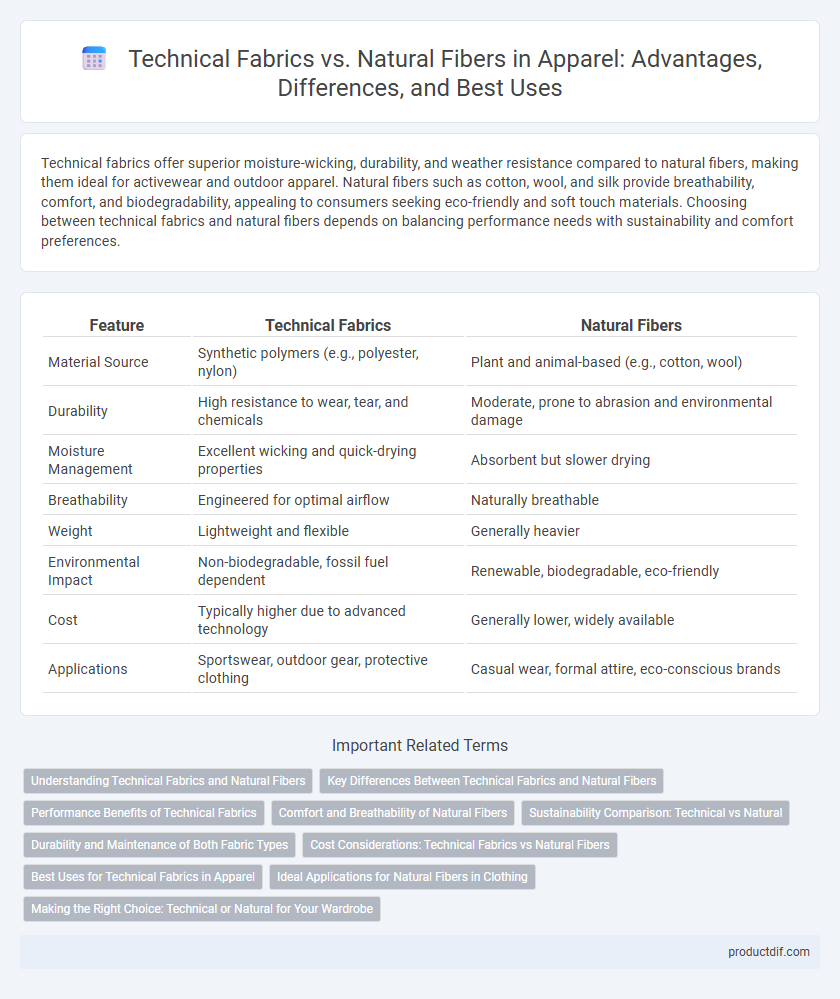Technical fabrics offer superior moisture-wicking, durability, and weather resistance compared to natural fibers, making them ideal for activewear and outdoor apparel. Natural fibers such as cotton, wool, and silk provide breathability, comfort, and biodegradability, appealing to consumers seeking eco-friendly and soft touch materials. Choosing between technical fabrics and natural fibers depends on balancing performance needs with sustainability and comfort preferences.
Table of Comparison
| Feature | Technical Fabrics | Natural Fibers |
|---|---|---|
| Material Source | Synthetic polymers (e.g., polyester, nylon) | Plant and animal-based (e.g., cotton, wool) |
| Durability | High resistance to wear, tear, and chemicals | Moderate, prone to abrasion and environmental damage |
| Moisture Management | Excellent wicking and quick-drying properties | Absorbent but slower drying |
| Breathability | Engineered for optimal airflow | Naturally breathable |
| Weight | Lightweight and flexible | Generally heavier |
| Environmental Impact | Non-biodegradable, fossil fuel dependent | Renewable, biodegradable, eco-friendly |
| Cost | Typically higher due to advanced technology | Generally lower, widely available |
| Applications | Sportswear, outdoor gear, protective clothing | Casual wear, formal attire, eco-conscious brands |
Understanding Technical Fabrics and Natural Fibers
Technical fabrics, engineered from synthetic polymers like polyester, nylon, and spandex, offer enhanced durability, moisture-wicking, and weather resistance ideal for high-performance apparel. Natural fibers such as cotton, wool, and silk provide breathability, biodegradability, and a softer feel, valued for comfort and sustainability in everyday wear. Comparing these materials reveals key differences in environmental impact, functionality, and maintenance, guiding consumers and designers toward informed fabric choices in apparel production.
Key Differences Between Technical Fabrics and Natural Fibers
Technical fabrics, engineered from synthetic fibers like polyester, nylon, and spandex, offer enhanced durability, moisture-wicking, and weather resistance compared to natural fibers such as cotton, wool, and silk. Natural fibers provide superior breathability, biodegradability, and comfort but generally require more care and have less resistance to environmental factors. The key differences lie in performance attributes, maintenance needs, and environmental impact, shaping their suitability for various apparel applications.
Performance Benefits of Technical Fabrics
Technical fabrics offer superior moisture-wicking, enhanced durability, and advanced breathability compared to natural fibers, making them ideal for high-performance apparel. Engineered with synthetic polymers like polyester and nylon, these fabrics provide resistance to abrasion, quick-drying capabilities, and UV protection. Their lightweight structure and stretchability improve athletic performance and comfort in demanding environments.
Comfort and Breathability of Natural Fibers
Natural fibers such as cotton, wool, and linen offer superior comfort and breathability compared to many technical fabrics due to their inherent ability to absorb moisture and allow air circulation. These fibers regulate temperature effectively, keeping the wearer cool and dry by wicking sweat away from the skin. Unlike synthetic technical fabrics, natural fibers reduce the risk of skin irritation and provide a softer, more breathable feel, making them ideal for everyday and sensitive skin use.
Sustainability Comparison: Technical vs Natural
Technical fabrics often utilize synthetic fibers such as polyester and nylon, which demand high energy consumption and fossil fuel resources during production, raising concerns about environmental impact and microplastic pollution. Natural fibers like organic cotton, hemp, and linen are biodegradable, require less water and pesticides compared to conventional cotton, and support soil health, making them a more sustainable choice in apparel manufacturing. However, innovations in recycling and bio-based synthetics are narrowing the sustainability gap between technical fabrics and natural fibers by reducing resource use and extending material lifecycle.
Durability and Maintenance of Both Fabric Types
Technical fabrics, such as polyester and nylon, offer superior durability with resistance to abrasion, moisture, and UV exposure, making them ideal for high-performance and outdoor apparel. Natural fibers like cotton and wool require more careful maintenance, including gentle washing and protection from shrinking or damage, but they provide breathability and comfort. The longevity of technical fabrics often surpasses that of natural fibers, reducing the frequency of replacement and maintenance efforts.
Cost Considerations: Technical Fabrics vs Natural Fibers
Technical fabrics often incur higher production costs due to advanced manufacturing processes and specialized materials, impacting retail pricing compared to natural fibers like cotton or wool, which benefit from established, large-scale agricultural supply chains. Despite higher upfront costs, technical fabrics can offer long-term value through enhanced durability, moisture-wicking properties, and weather resistance, often reducing replacement frequency. Natural fibers typically present lower initial expenses but may require more maintenance and have shorter lifespan in performance-oriented apparel applications.
Best Uses for Technical Fabrics in Apparel
Technical fabrics excel in performance apparel due to their moisture-wicking, breathability, and durability, making them ideal for activewear, outdoor gear, and sports clothing. Their synthetic properties offer superior resistance to water, wind, and UV rays compared to natural fibers, enhancing comfort and protection in extreme conditions. Common materials like polyester, nylon, and spandex enable lightweight, stretchy, and quick-drying garments suited for athletes and outdoor enthusiasts.
Ideal Applications for Natural Fibers in Clothing
Natural fibers such as cotton, wool, and linen excel in apparel applications requiring breathability, moisture absorption, and comfort against the skin. Their biodegradability and hypoallergenic properties make them ideal for everyday wear, casual clothing, and eco-conscious fashion lines. Natural fibers also perform well in warm climates due to their ability to regulate temperature and wick away sweat effectively.
Making the Right Choice: Technical or Natural for Your Wardrobe
Technical fabrics, engineered for durability, moisture-wicking, and breathability, offer superior performance in activewear and outdoor apparel. Natural fibers like cotton, wool, and linen provide comfort, breathability, and sustainability, making them ideal for everyday wear and eco-conscious consumers. Evaluating your lifestyle and intended use ensures the right balance between the advanced features of technical fabrics and the comfort and sustainability of natural fibers in your wardrobe.
Technical Fabrics vs Natural Fibers Infographic

 productdif.com
productdif.com